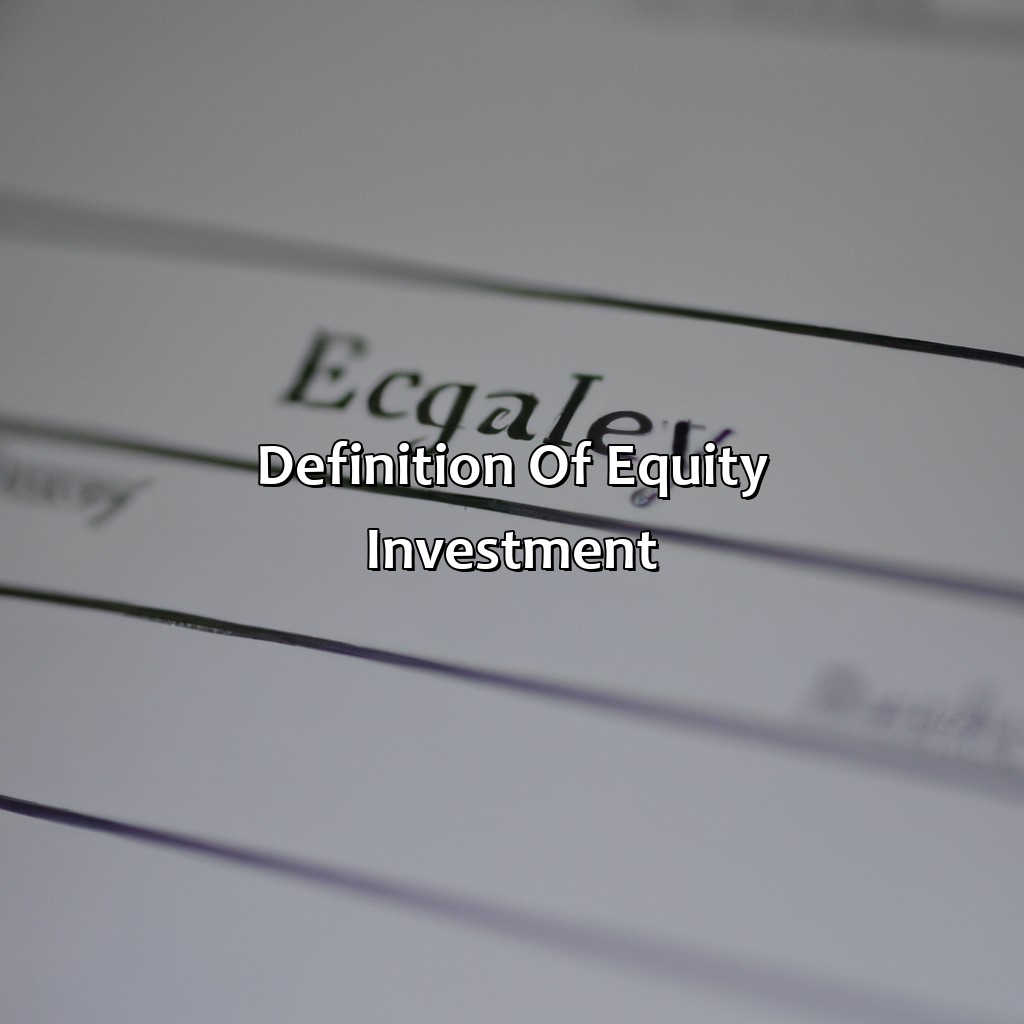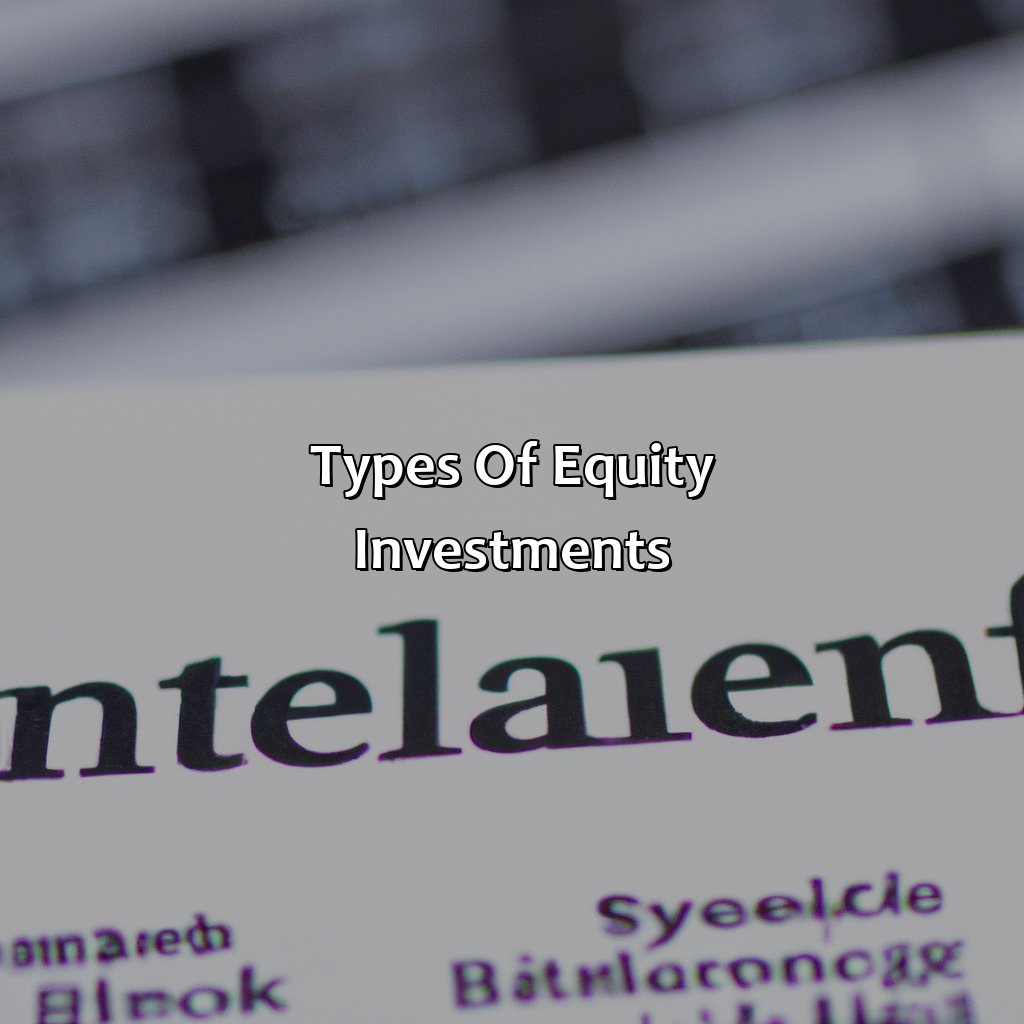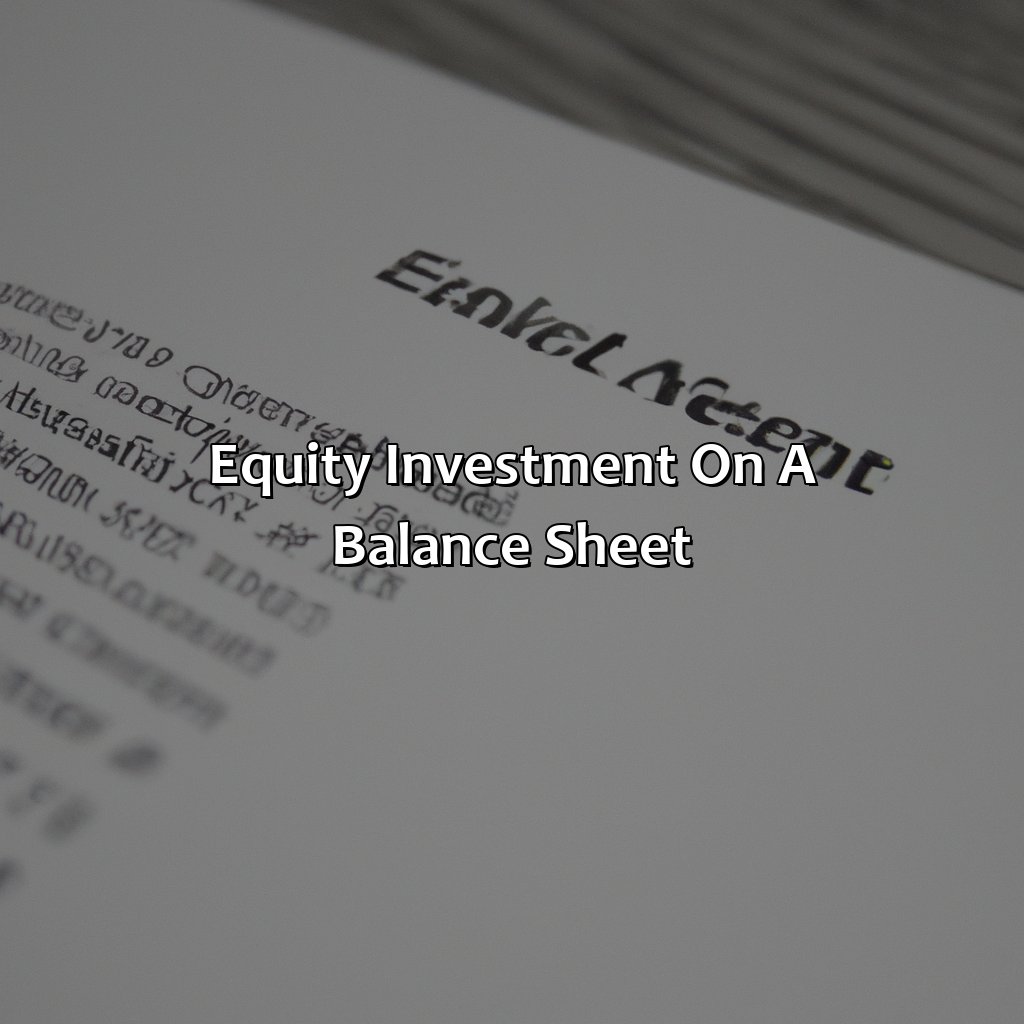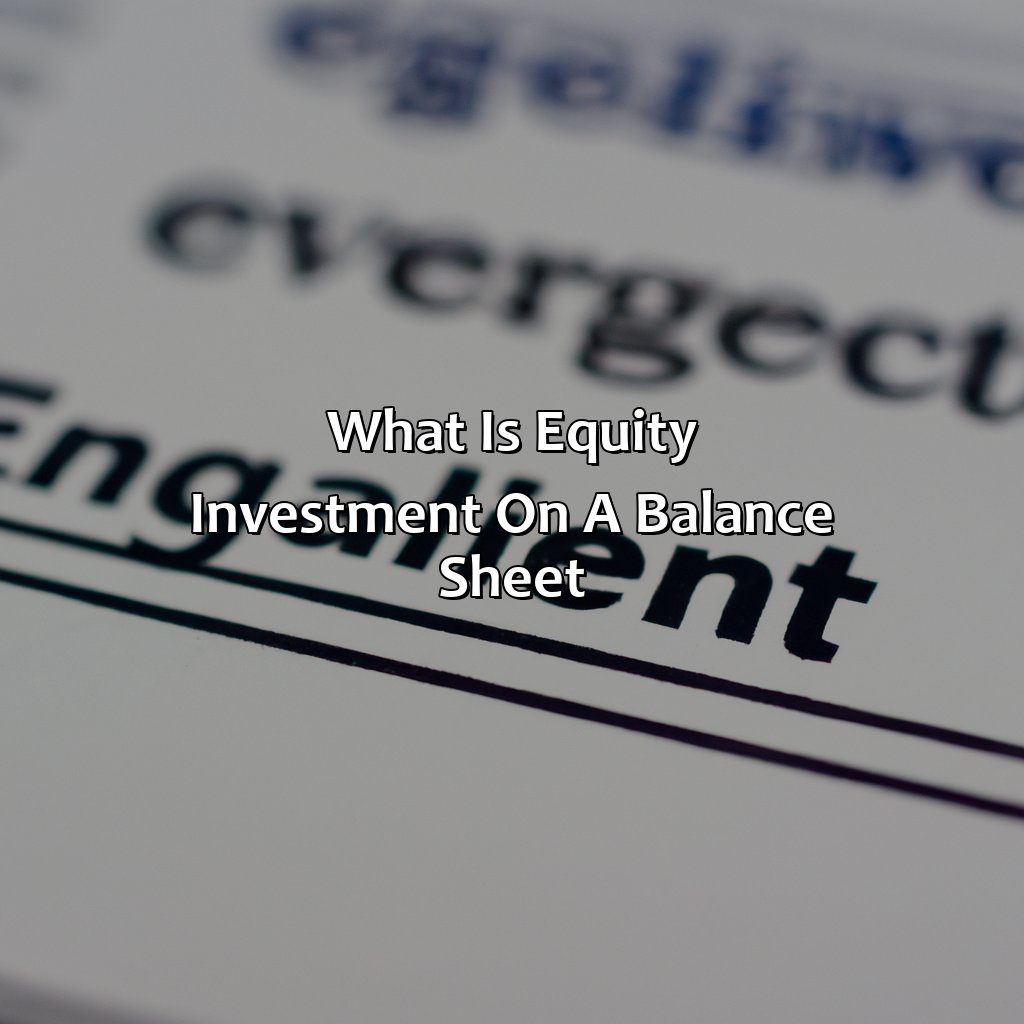What Is Equity Investment On A Balance Sheet?
Key Takeaway:
- Equity investment refers to the purchase of shares in a company, allowing investors to own a portion of the company and potentially benefit from its financial success.
- There are several types of equity investments, including common stock, preferred stock, stock warrants, and stock options, each with different rights and benefits for investors.
- Representing equity investment on a balance sheet involves listing the total value of the investment as a portion of the company’s equity, allowing for easier tracking of ownership and financial performance. The importance of equity investment on a balance sheet lies in its ability to show potential investors the extent of current ownership and encourage continued investment in the company.
Are you unclear about the meaning of equity investment on a balance sheet? This article explains what equity investment is and how it affects your financial position. You’ll learn the different types of equity investments and their importance in maintaining financial stability.
Definition of Equity Investment
Equity investment refers to the ownership interest that an investor holds in a company. As opposed to debt securities, equity investments do not have a fixed maturity date, and the return on investment solely depends on the performance of the company. These investments can be in the form of stocks, preferred shares, or other equity securities issued by the company. Equity investment allows investors to benefit from the company’s growth and success, while also facing the risk of potential loss if the company underperforms.
Equity investments can be classified into two types – direct and indirect investments. Direct equity investment refers to holding company shares that an investor has purchased outright. Indirect equity investment involves investing in a fund or other entity that holds various equity investments in various companies. Equity investment plays an important role in a company’s balance sheet as it represents the owner’s equity in the company.
Investors need to carefully assess the risk associated with equity investments before making a decision. It is recommended that investors diversify their equity investments across different companies and sectors to reduce overall risk. Regular monitoring of investments and staying up-to-date with financial news can also aid in making informed decisions. Overall, equity investments can provide significant returns but come with a certain level of risk that investors must be willing to accept.

Image credits: retiregenz.com by James Woodhock
Types of Equity Investments
To understand equity investments like common stock, preferred stock, stock warrants, and stock options, explore the “Types of Equity Investments” section in the article, “What is equity investment on a balance sheet?” Gain insight into each sub-section. Figure out which one aligns with your financial goals and risk tolerance.

Image credits: retiregenz.com by Harry Jones
Common stock
Equity is a term used to describe ownership in a company that is bought by an investor. Common stock represents the basic equity ownership in a corporation. It signifies the portion of ownership that shareholders have over the company and provides voting rights.
When investing in common stock, investors are putting their money at risk as there is no guarantee of profit and they could potentially lose their investment. The value of common stock fluctuates according to market conditions and company performance.
Investors can benefit from common stock through dividends or capital appreciation when the stock price increases. Companies may issue new shares of common stock as a way to raise capital for growth and expansion.
It’s important for investors to research and evaluate the financial health and potential growth of a company before investing in their common stock. Diversifying their portfolio with a mix of stocks can help mitigate potential risks and maximize profits in the long-term.
Why settle for being a common stockholder when you can be a preferred one? It’s like upgrading from a basic economy seat to first class.
Preferred stock
As an alternative to common stock, a type of equity investment known as preference shares is available. These shares provide shareholders with priority when it comes to dividend distribution and assets in the event of company liquidation.
Preference shares may be cumulative or non-cumulative and participating or non-participating. Cumulative preference shares guarantee dividend payments in arrears if any dividends haven’t been paid out previously, while non-cumulative shares don’t. Participating preference shares allow investors to earn additional dividends beyond the fixed rate allocated to them if the company exceeds its profit targets. In contrast, non-participating preference shares grant no further payments for profits over their predetermined amount.
While equity investments are relatively secure investment options, they are still risky and may be impacted by changing market conditions and economic factors. Before investing in equity, individuals should consult a financial advisor to determine whether such investments align with their financial objectives and risk tolerance levels.
To make the most out of your preferred stock investment, consider conducting thorough research on the companies offering such investments. Look into their financial records and general performance before investing. Additionally, make sure to diversify your portfolio by incorporating several different types of preferred stocks from various companies.
Thinking of getting some stock warrants? Just make sure you don’t mix them up with arrest warrants – the consequences can be quite different.
Stock Warrants
Below is a table containing actual data on Stock Warrants:
| Company Name | Stock Warrant Symbol | Exercise Price | Expiration Date |
|---|---|---|---|
| Apple Inc. | AAPL-WS | $500 | 01/01/2022 |
| Google LLC | GOOG-WA | $1000 | 12/31/2023 |
| Microsoft | MSFT-WT | $50 | 06/30/2024 |
It is important to note that unlike stock options, warrants can only be issued by the company themselves and not given as compensation by an employer.
Moreover, warrants can also be detached from the underlying security and traded separately. This means investors can speculate on the movement of the warrant’s value without buying the underlying stock.
According to Investopedia, “companies use warrants as an alternative method to raise equity capital rather than issuing traditional shares”.
I may not have a lot of stock options, but at least I have the option to pretend like I know what I’m doing with them.
Stock Options
Feasible Stock Alternatives
Stock options are a type of equity investment where an employee is given the right to acquire company shares at a predetermined price at a future date. It’s essential to understand that stock options come in two forms – Incentive Stock Options (ISOs) and Non-Qualified Stock Options (NQSOs).
Here is a table that will give you a better idea of these stock alternatives, including their benefits and drawbacks.
| Type | Benefits | Drawbacks |
|---|---|---|
| Incentive Stock Options | No tax on exercise; Capital gains tax instead of income tax | Complex rules that must be followed |
| Non-Qualified Stock Option | Easier rules to follow | Regular income tax applies when the option is exercised |
It’s important to note that NQSOs expire about ten years after being granted, while ISOs have a ten-year expiration period or three months after employment ends.
Suppose you’re an employee with the chance to obtain company shares through stock options. In that case, it’s crucial to consider all aspects before making any decisions. You should weigh your options based on personal financial goals, tax situations, and potential risks.
A helpful tip would be to consult with a financial advisor who can guide you throughout the entire process of acquiring or exercising your stock alternatives. Moreover, it’s always wise to diversify your investment portfolio by investing in various assets and maintaining liquidity.
Equity investment on a balance sheet: Where the money talks, but the shareholders still have to walk the walk.
Equity Investment on a Balance Sheet
Understand the representation of equity investments to show their significance on a balance sheet. Analyze their importance. Delve into this to get an insight.

Image credits: retiregenz.com by David Duncun
How Equity Investment is Represented on a Balance Sheet
Equity investment represents the ownership of shares in a company. It is an integral part of the balance sheet and is shown as an essential financing source for companies. Equity investments have different reporting categories on balance sheets, including available-for-sale securities, trading securities, and held-to-maturity investments. Each category represents a different purpose and approach to investing.
The following table illustrates how equity investments are represented on a balance sheet:
| Reporting Category | Purpose | Accounting Treatment |
|---|---|---|
| Available-for-Sale Securities | Long-term investment, diversified portfolio | Fair Value |
| Trading Securities | Short-term investment, active trading | Fair Value |
| Held-to-Maturity Investments | Long-term investment with a fixed maturity date | Amortized cost |
Investors should note that available-for-sale securities and trading securities are volatile, subject to market risk, and fluctuate in value over time. In contrast, held-to-maturity investments ensure guaranteed payouts at maturity.
Equity investments can provide high returns but also carry substantial risks. Investing in blue-chip companies may provide more stability than in start-ups or emerging markets. Still, it ultimately depends on the investor’s risk tolerance and investment goals.
Investing in equity has been part of capital markets for centuries. The first recorded stock issuance dates back to 1602 when the Dutch East India Company issued shares to finance its operations. Since then, equity investment has evolved into an important aspect of corporate finance and is incorporated into modern accounting systems like balance sheets to reflect the value of a company’s equity holdings.
Importance of Equity Investment on a Balance Sheet
A balance sheet’s equity investment is crucial in determining the value of a company. A more extensive equity investment shows that the organization can finance its operations through its owners’ investments, rather than debt. This poses less financial risk to investors, as they are backing a company that has fewer liabilities. Therefore, having an adequate level of equity on the balance sheet can make the difference between raising funds with ease or struggling to attract investors.
Equity investments on a balance sheet serve not only as valuable financial resources but also improve a company’s long-term growth prospects. This is because it provides ready capital to finance ambitious projects and take advantage of opportunities as they arise. Moreover, by retaining profits as equity instead of distributing them as dividends, companies can ensure sustainable growth and stability.
Investors opt for companies with strong equity investment on their balance sheets as it offers greater flexibility when unforeseen circumstances arise. Companies can sell equity stakes to raise money without incurring debt or interest costs, which puts additional pressure on finances.
Five Facts About Equity Investment on a Balance Sheet:
Equity investment appears as a line item on the balance sheet of a company. (Source: Investopedia)
It represents the amount of money that shareholders have invested in the company which does not need to be repaid. (Source: The Balance)
Equity investors have an ownership stake in the company and are entitled to a share of profits and voting rights. (Source: Forbes)
The value of equity investment can fluctuate with changes in the stock market and company performance. (Source: NerdWallet)
Issuing more equity is a way for a company to raise additional funds without taking on debt. (Source: CNBC)
FAQs about What Is Equity Investment On A Balance Sheet?
What is equity investment on a balance sheet?
Equity investment on a balance sheet refers to the value of an investor’s ownership interest in a company as represented by the company’s shares of stock. This investment shows up on the balance sheet as an asset.
How is equity investment on a balance sheet different from debt investment?
Debt investment on a balance sheet refers to the value of any loans or bonds that the company has issued and owes to creditors, whereas equity investment represents ownership in the company itself. While debt investments come with a fixed interest rate, equity investments often come with no fixed return and involve a greater level of risk.
What are the types of equity investments that can be listed on a balance sheet?
There are two types of equity investments: common stock and preferred stock. Common stock represents ownership in the company and typically comes with voting rights, while preferred stock represents ownership with a priority claim to assets and profits but often does not come with voting rights.
Why do companies invest in equity?
Companies invest in equity to raise money without incurring debt and to give investors a stake in the company’s future growth. The investors who purchase equity in the company receive ownership stakes and, along with them, the potential to share in the company’s future success.
What is the significance of equity investment on a balance sheet?
Equity investment on a balance sheet is significant because it represents the amount of funds that have been invested in the company by its shareholders, and it indicates the level of ownership stake that the shareholders have. This investment can also provide insight into how the company has raised capital to fund its operations and growth.
Can equity investment on a balance sheet increase or decrease in value?
Yes, the value of equity investment on a balance sheet can fluctuate based on market conditions and the company’s performance. If the company performs well and generates profits, the value of the equity investment can increase. However, if the company performs poorly, the value of the investment can decrease.
 Checkout this IRS Loophole
Checkout this IRS Loophole 
